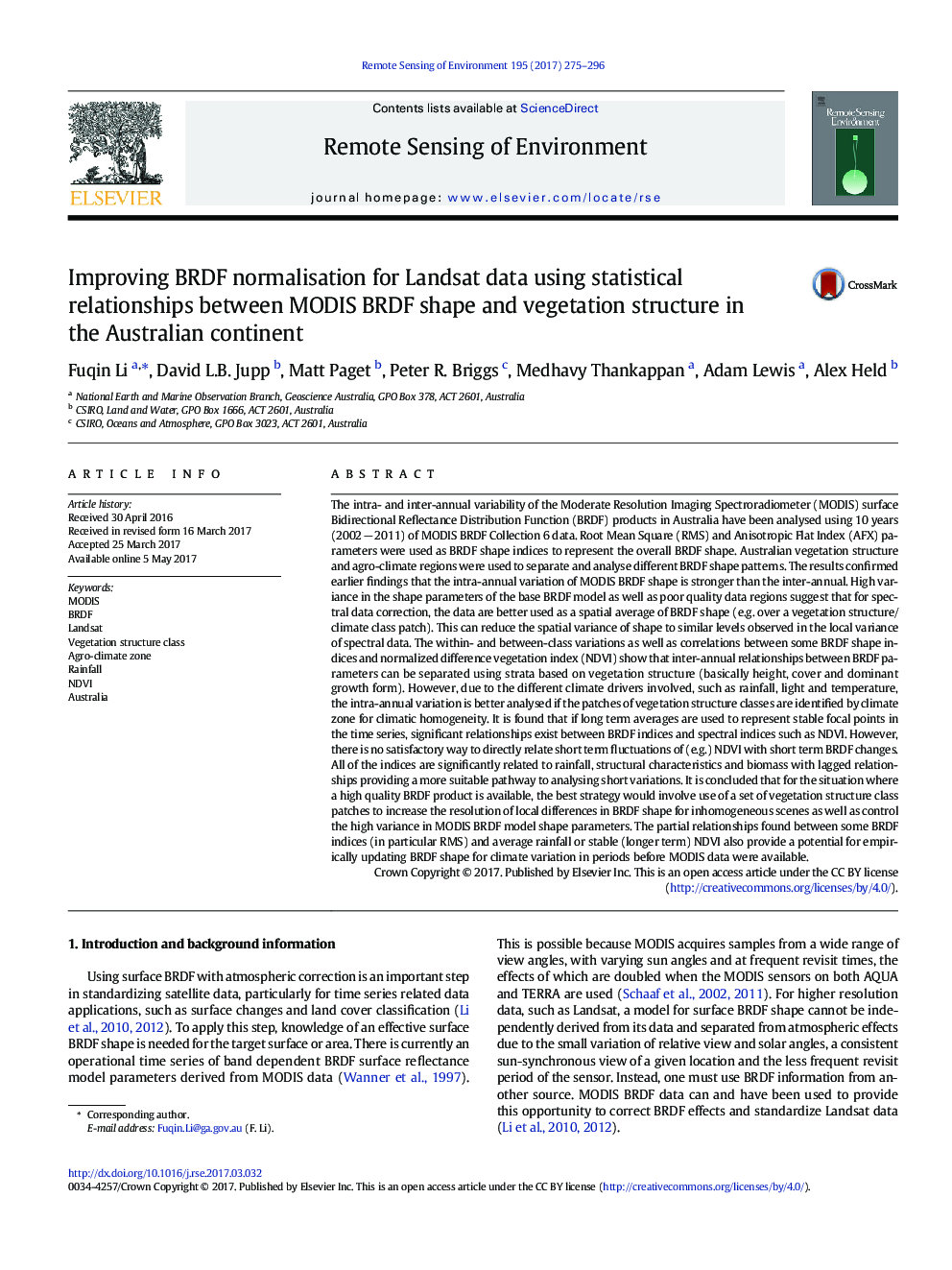| کد مقاله | کد نشریه | سال انتشار | مقاله انگلیسی | نسخه تمام متن |
|---|---|---|---|---|
| 5754821 | 1621205 | 2017 | 22 صفحه PDF | دانلود رایگان |

- Intra-annual variation MODIS BRDF shape is greater than inter-annual in Australia.
- BRDF parameters can be separated by structures using vegetation structure classes.
- Strong temporal relationships exist between BRDF indices and rainfall in Australia.
- Empirical adjustment of inter-annual BRDF can potentially use rainfall in Australia.
- Allowed improved BRDF correction of Landsat data in Australia.
The intra- and inter-annual variability of the Moderate Resolution Imaging Spectroradiometer (MODIS) surface Bidirectional Reflectance Distribution Function (BRDF) products in Australia have been analysed using 10 years (2002 â 2011) of MODIS BRDF Collection 6 data. Root Mean Square (RMS) and Anisotropic Flat Index (AFX) parameters were used as BRDF shape indices to represent the overall BRDF shape. Australian vegetation structure and agro-climate regions were used to separate and analyse different BRDF shape patterns. The results confirmed earlier findings that the intra-annual variation of MODIS BRDF shape is stronger than the inter-annual. High variance in the shape parameters of the base BRDF model as well as poor quality data regions suggest that for spectral data correction, the data are better used as a spatial average of BRDF shape (e.g. over a vegetation structure/climate class patch). This can reduce the spatial variance of shape to similar levels observed in the local variance of spectral data. The within- and between-class variations as well as correlations between some BRDF shape indices and normalized difference vegetation index (NDVI) show that inter-annual relationships between BRDF parameters can be separated using strata based on vegetation structure (basically height, cover and dominant growth form). However, due to the different climate drivers involved, such as rainfall, light and temperature, the intra-annual variation is better analysed if the patches of vegetation structure classes are identified by climate zone for climatic homogeneity. It is found that if long term averages are used to represent stable focal points in the time series, significant relationships exist between BRDF indices and spectral indices such as NDVI. However, there is no satisfactory way to directly relate short term fluctuations of (e.g.) NDVI with short term BRDF changes. All of the indices are significantly related to rainfall, structural characteristics and biomass with lagged relationships providing a more suitable pathway to analysing short variations. It is concluded that for the situation where a high quality BRDF product is available, the best strategy would involve use of a set of vegetation structure class patches to increase the resolution of local differences in BRDF shape for inhomogeneous scenes as well as control the high variance in MODIS BRDF model shape parameters. The partial relationships found between some BRDF indices (in particular RMS) and average rainfall or stable (longer term) NDVI also provide a potential for empirically updating BRDF shape for climate variation in periods before MODIS data were available.
Journal: Remote Sensing of Environment - Volume 195, 15 June 2017, Pages 275-296